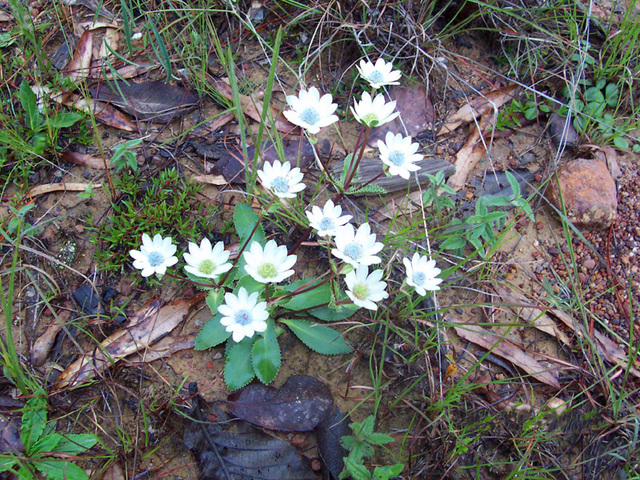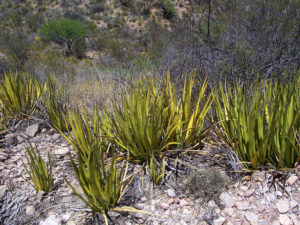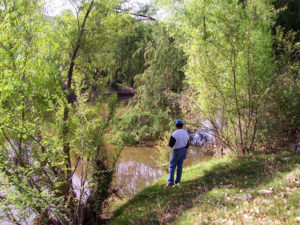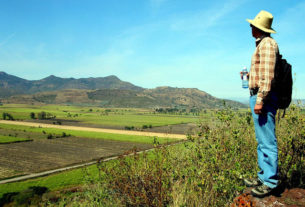Driving across the state of Durango, flowers paint each region’s landscapes with local colors. Wildflower lovers enjoy Durangan flowers nearly all year long because a few hardy species tough out the region’s mild winters. Even so, mid- to late-summer and early-fall stage Durango’s most spectacular wildflower show, with composites lining roadsides, converting them into flowing yellow ribbons among the hillsides. Cosmos flowers invade fallow agricultural fields and convert them into impressionistic pink-dabbled “dot-scapes” among green forests.

Durangan Plant Diversity
More than 3,000 plant species live within Durango’s 123 thousand square kilometers (about 47 thousand square miles, making its land area approximately equivalent to that of the U.S. states of Mississippi, Pennsylvania, or Ohio). That’s a lot of biodiversity within the state, compared to most regions to the north. The state owes its wide biological diversity to its variable topographic relief, different soil types, and climatic variation which, from region to region, generate environmental differences important to plant speciation and conditions for many plant species.
Geographer Pastor Rouaix, in his book on the geography of Durango (1929), classified Durango’s regions into the semiarid region, the mountainous region, and the “quebradas” (literally, “broken mountains,” referring to deep canyons that penetrate the mountains from the lower, tropical coastal plains). Sixty years later in her book on the Durangan flora, pioneer botanist Dr. Ma. Socorro González-Elizondo further divided and classified the vegetation of these regions.
The deep barrancas of Rouaix’s quebradas region have allowed tropical vegetation to climb into Durango’s extreme western borders, where one finds fascinating and diverse tropical scrub – one of the world’s most biologically diverse vegetation types. The Tropic of Cancer passes through southern Durango, and tropical vegetation thrives on Durango’s low altitude Pacific slopes.
Temperate pine forests, pine-oak forests, and oak-pine forests dominate the high sierra of Rouaix’s mountain region. The temperate region produces Durango’s principal forest products, making the state one of the major wood producers in Mexico. One even finds small remnants of boreal pine forests, old growth forest, and mesic forest tucked away in Durango’s high sierra region. Mexican mesic forest survives as one of the world’s rarest and most endangered vegetation types.
At the eastern extreme of the Rouaix’s mountainous region, grasslands roll over the low sierra’s foothills, covering the central portion of the state with the fertile soils that have nurtured much of the state’s agricultural and livestock producers. Traveling eastward and elevationally downward from the grasslands, Chihuahuan desert scrub and associated desert vegetation types dominate.
Flowing through any of these vegetation types, one finds riverways, such as along the Río Nazas or Río Mezquital, where riparian vegetation winds through other vegetation types of the state. Rivers and streams sustain many wildflowers not found in other parts of the state.
Some Interesting Durangan Plants
Temperate Forest Plants
Topographic and climatic diversity characterize Durango’s temperate forest region, which includes small areas of conifer forests dominated by pines (pinos), firs (Pinabetes), spruces (Pinabete espinoso), and cedars (táscates). The endangered Mexican Spruce stands out as one of the most spectacular of these. Endemic to the Sierra Madre Occidental of Durango and Chihuahua and adapted to an ancient climate, few populations survive today. Abundant oak and pine forests (bosque de pino y encino) dominate most of the temperate forest region, and include many endemic plant species, such as the recently discovered Spoonleaf Oak (cucharón), Quercus tarahumara, and the pine (pino), Pinus oocarpa.
Wildflowers from this region include the matarique, which has a relatively inconspicuous flower and large, lobed leaves. Other wildflowers that paint the forest landscape include manzanillas (or Asters and their relatives, as they’re called north of the border), faralillos (columbines), orchids (orchídeas), spectacular bromeliads (cirulenches and gallos), nubes (sweet herbs), ferns (helechos), gallitos (spider plants), the indian paint-brushes (Castilleja spp.), wild marigolds (Tagetes spp.) and many others.

The dahlia (Dahlia spp.) is Mexico’s national flower, and three species of dahlia grow in Durango. Dahlia coccinea, the most widespread species of dahlia, has a red or yellow flower, and grows throughout the forested portion of the state. The blue-flowered Dahlia scherffii and Dahlia rupicola cover smaller geographical areas. The latter is perhaps one of the rarest flower species in Mexico. The dahlias in Durango are known as “daleas” or “cañas” by local campesinos. “Caña,” or cane, refers to the hollow, water-filled stem, which is a source of a parsley-flavored water that’s handy on a long, hot day in the field.
Another woodland species, the Mexican tarragon, or hierbanis, inhabits moist areas in the mountains. It grows mainly in the lower pine and oak forests, but also extends into higher grasslands with trees. Residents make a delicious tea with it, and the infusion is known to help control bacterial infections in the digestive system. Nurseries outside of Mexico sell the plant as an ornamental valued for its tiny, bright yellow flowers and dark green foliage.
Grassland Plants
Endless grasslands cover the big-sky landscapes that made Durango an important filming region for the international cinema. Many spectacular wildflowers grow among the grasses and grassland shrubs. Interesting flowers from this region include rattlesnake master (hierba del sapo… literally, “toad plant”), with it’s waxy blue foliage and flowers, many cactus species (bisnagas and nopales), apache plumes (plumillas), huisaches (Vachellia farnesiana), locoweeds, morning glories (campanas), buffalo gourd (calabacita hedeonda), sotol (Dasylirion wheelerii) and many grass (Poaceae) and composite (Asteraceae) species.
During late summer, in the middle- to high-elevation agricultural areas of Durango, cosmos flowers cover fallow, rolling hills. Known simply as “cosmos,” “mirasol,” and, even, “dalea” in Durango’s pueblos, the flowers of the species of cosmos are generally pink or white, and can cover entire landscapes in late summer with tiny colored dots.
Tropical Plants
Durango’s quebradas, in the western portion of the state where the Sierra Madre Occidental abruptly drops off above the Pacific Coast, contain patches of tropical or semi-tropical forest. These forests nurture impressive trees that reach enormous heights. Interesting trees of the tropical quebradas include the toat-thorned acacia (tepemezquite), tree catclaw (tésota, guache), many other catclaws and gatuños (Acacia spp.), black tower (torote prieto), papelillos, mountain ebony, arborescent morning glory (palo santo or palo bobo), and pochotes. Much of Durango’s tropical areas are still relatively inaccessible, but one can see good areas along the highways to Canelas and Topia, and, just beyond the Durangan border, on the highway to Mazatlán.
Desert Plants
Hard-core wildflower hunters will find many bizarre plant species in Durango’s desert regions. The state’s Zona de Silencio (the Zone of Silence) contains many fantastic desert landscapes and many opportunities for adventure hungry travelers on the path of interesting wildflowers. Cactus species generally bloom from April through May, and often into June, in the region, and many other wildflowers sprinkle the spiny desert landscape with color during the rest of the summer.
Night-blooming cereus (Peniocereus greggii), know locally as “reina de la noche” (queen of the night) or “huevo de venado” (literally, “deer egg,” named for its bulbous, medicinally important root), hides out among other desert shrubs, like creosote bush (Larrea tridentata) and mezquites (Prosopis glandulosa). But in the mornings, when it’s spectacular, tell-tale white flowers give away its hideout. Extremely rare in the U.S., it appears to be more common in Mexico. Illegal and uncontrolled collection of plants for their root threatens large populations in Durango and surrounding states.
Many bisnagas and pitayas (cacti), including species of the genera Mammilaria, Coryphantha, Echinocereus and Echinocactus, are common in desert areas. Locals call some of the smaller cacti “pitayas,” in reference to their sweet, pitaya fruit, “chilillos,” referring to the tiny chile pepper-like fruit, or chivitos (literally, “little goats”). Common names vary from region to region and even from pueblo to pueblo within a region. Enormous barrel cacti (Ferocactus spp.) are still abundant in some areas, despite habitat loss and illegal collection for dulce de bisnaga (cactus candy) production. Peyotes, mostly cacti of the genera Lophophora and Ancistrocactus, grow in more remote sites. Collection for religious ceremonies and recreational narcotic use have greatly reduced species populations. Nopales (prickly pears from the genus Opuntia) and cardos (chollas) grow in most desert habitats, and one may enjoy a variety of tuna (prickly pear fruits) colors, sizes, and flavors in Durangan desert. Try some chilled tunas after a hot desert hike!
Aside from the many cactus species in the Chihuahuan Desert Region, one may observe other interesting succulents, like sotol, agaves (known as maguey in Mexico), yuccas (Yucca spp.), and others. Desert wildflowers include desert marigold (ceniza), many asters, spiny asters (called “árnica“, and used like true Arnica), grasses, and many others. The desert willow (mimbre) has spectacular pink, to white flowers in arroyos throughout the Chihuahuan Desert Region. A close relative of the desert willow, yellow trumpet flower (Tecoma stans) also has large, yellow, tubular flowers. The yellow trumpet flower is known to campesinos as retama, jamoncillos, jarilla or esperanza. Yellow trumpet flower is common on hillsides in both grasslands and desert habitats.
Riverine Plants
Riverways make habitat for many species that one would not normally find in semi-arid or arid areas. Look for willows (saúz), cottonwoods (álamo), Moctezuma cypress (sabino), water lilies (lirios acuáticos), grasses, and sedges and rushes (zacates) along Durangan waterways.
Travel Prepared
Wildflower enthusiasts traveling in Durango should prepare for field conditions. Durangan weather can change rapidly during any part of the year. Summer mornings, for example, can be hot and clear and, by mid-afternoon, cool rain storms are common. One might encounter temperatures in the 90s in the low desert and climb into the mountains to find snowfall on the same day. Winter temperatures can reach freezing in most parts of the state. Hikers should bring along sunscreen, good hiking boots, and clothing for almost any weather conditions. Trails are generally undeveloped, and good boots are a must almost anywhere in Durango… even in many of the pueblos. Keep a blanket tucked away in the trunk for emergencies and also for passengers who want to take a nap on long Durangan highways.
Travelers should carry plenty of bottled water and a decent tool kit. Outside of Durango’s major cities, water and reliable mechanics may be difficult to find. First time travelers in Mexico might want to read a bit on camping and traveling in Mexico before throwing a field guide and cooler into the car and driving across the border. Wildflower hunters will find that field guides are next to non-existent. Look for information on Internet, and buy field guides to wildflowers in the U.S. states adjacent to the border. Many of the species found in Durango also grow in New Mexico, Texas and Arizona, but many Durangan species do not grow in the U.S. Persons wanting identifications may have to look for help from regional experts in the U.S. or Mexico. However, travelers who take lots of photos of interesting flowers, shrubs, trees, and landscapes will find more than enough to fill their camera memories with images.
Conservation of Durangan Wildflowers
The world’s biodiversity is quickly disappearing, putting at risk our own existence on the planet. Durango is no exception. Overgrazing, poor forest management practices, and agricultural and urban development have fragmented and degraded the Durangan ecosystems since the industrial revolution, and abuses continue today. Wildflower collectors can threaten the very same species that they adore. When enjoying Durango’s flora, take only photos and memories. One can also help save Durango’s biodiversity by practicing environmentally sound practices at home (reduced meat consumption, reduced consumerism, petroleum, water, and electricity conservation, etc.), financially supporting non-government organizations that work in Durango to conserve biodiversity, and by encouraging the integration of environmentally friendly product industries in Mexico through purchase of their products.
Enjoy Durango’s wildflowers!


















